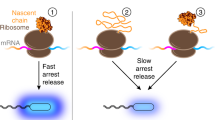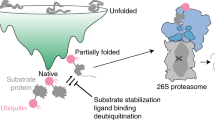Abstract
The α-helix is a fundamental protein structural motif and is frequently terminated by a glycine residue1,2,3,4,5. Explanations for the predominance of glycine at the C-cap terminal portions of α-helices have invoked uniquely favorable energetics of this residue in a left-handed conformation4 or enhanced solvation of the peptide backbone because of the absence of a side chain6. Attempts to quantify the contributions of these two effects have been made previously, but the issue remains unresolved. Here we have used chemical protein synthesis to dissect the energetic basis of α-helix termination by comparing a series of ubiquitin variants containing an L-amino acid or the corresponding D-amino acid at the C-cap Gly35 position. D-Amino acids can adopt a left-handed conformation without energetic penalty, so the contributions of conformational strain and backbone solvation can thus be separated. Analysis of the thermodynamic data revealed that the preference for glycine at the C′ position of a helix is predominantly a conformational effect.
This is a preview of subscription content, access via your institution
Access options
Subscribe to this journal
Receive 12 print issues and online access
$259.00 per year
only $21.58 per issue
Buy this article
- Purchase on Springer Link
- Instant access to full article PDF
Prices may be subject to local taxes which are calculated during checkout



Similar content being viewed by others
References
Pauling, L. & Corey, R.B. Hydrogen-bonded spiral configurations of the polypeptide chain. J. Am. Chem. Soc. 72, 5349 (1950).
Pauling, L., Corey, R.B. & Branson, H.R. The structure of proteins: two hydrogen-bonded helical configurations of the polypeptide chain. Proc. Natl. Acad. Sci. USA 37, 205–211 (1951).
Richardson, J.S. & Richardson, D.C. Amino acid preferences for specific locations; at the ends of α-helix. Science 240, 1648–1652 (1988).
Aurora, R., Srinivasan, R. & Rose, G.D. Rules for α-helix termination by glycine. Science 264, 1126–1130 (1994).
Ermolenko, D.N., Thomas, S.T., Aurora, R., Gronrnborn, A.M. & Makhatadze, G.I. Hydrophobic interactions at the Ccap position of the C-capping motif of a-helices. J. Mol. Biol. 322, 123–135 (2002).
Serrano, L., Sancho, J., Hirshberg, M. & Fersht, A.R. α-helix stability in proteins I. Empirical correlations concerning substitution of side-chains at the N- and C-caps and the replacement of alanine by glycine or serine at solvent-exposed surfaces. J. Mol. Biol. 227, 544–559 (1992).
Doig, A.J. & Baldwin, R.L. N- and C-capping preferences for all 20 amino acids in α-helical peptides. Protein Sci. 4, 1325–1335 (1995).
Schneider, J.P. & DeGrado, W.F. The design of efficient α-helical C-capping auxiliaries. J. Am. Chem. Soc. 120, 2764–2767 (1998).
Kapp, G.T., Richardson, J.S. & Oas, T.G. Kinetic role of helix caps in protein folding is context-dependent. Biochemistry 43, 3814–3823 (2004).
Thomas, S.T., Loladze, V.V. & Makhatadze, G.I. Hydration of the peptide backbone largely defines the thermodynamic propensity scale of residues at the C′ position of the C-capping box of α-helix. Proc. Natl. Acad. Sci. USA 98, 10670–10675 (2001).
Krantz, B.A. & Sosnick, T.R. Distinguishing between two-state and three-state models for ubiquitin folding. Biochemistry 39, 11696–11707 (2000).
Dawson, P.E. & Kent, S.B. Synthesis of native proteins by chemical ligation. Annu. Rev. Biochem. 69, 923–960 (2000).
Bang, D., Makhatadze, G.I., Tereshko, V., Kossiakoff, A.A. & Kent, S.B. Total chemical synthesis and X-ray crystal structure of a protein diastereomer: [D-Gln35]ubiquitin. Angew. Chem. Int. Edn. Engl. 44, 3852–3856 (2005).
Bang, D. & Kent, S.B. A one-pot synthesis of crambin. Angew. Chem. Int. Edn. Engl. 43, 2534–2538 (2004).
Dawson, P.E., Muir, T.W., Clark-Lewis, I. & Kent, S.B. Synthesis of proteins by native chemical ligation. Science 266, 776–779 (1994).
Yan, L.Z. & Dawson, P.E. Synthesis of peptides and proteins without cysteine residues by native chemical ligation combined with desulfurization. J. Am. Chem. Soc. 123, 526–533 (2001).
Anil, B., Song, B., Tang, Y. & Raleigh, D.P. Exploiting the right side of the Ramachandran plot: substitution of glycines by D-alanine can significantly increase protein stability. J. Am. Chem. Soc. 126, 13194–13195 (2004).
Hermans, J., Anderson, A.G. & Yun, R.H. Differential helix propensity of small apolar side chains studied by molecular dynamics simulations. Biochemistry 31, 5646–5653 (1992).
Schnölzer, M., Alewood, P, Jones, A., Alewood, D & Kent, S.B. In situ neutralization in Boc-chemistry solid phase peptide synthesis. Rapid, high yield assembly of difficult sequences. Int. J. Pept. Protein Res. 40, 180–193 (1992).
Hackeng, T.M., Griffin, J.H. & Dawson, P.E. Protein synthesis by native chemical ligation: expanded scope by using straightforward methodology. Proc. Natl. Acad. Sci. USA 96, 10068–10073 (1999).
Acknowledgements
This research was supported by the US Department of Energy Genomes to Life Genomics Program grant DE-FG02-04ER63786 (to S.B.K.), the US National Science Foundation Materials Research Science and Engineering Centers Program at the University of Chicago (grant DMR-0213745), and by US National Institutes of Health grant GM54537 (to G.I.M.). Use of the Advanced Photon Source was supported by the US Department of Energy, Basic Energy Sciences, Office of Science, under Contract No. W-31-109-Eng-38. Portions of this work were performed at the Industrial Macromolecular Crystallography Association (IMCA-CAT) and at the DuPont-Northwestern-Dow Collaborative Access Team (DND-CAT) located in 17ID and 5ID, respectively, of the Advanced Photon Source. Use of the IMCA-CAT was supported by the companies of the Industrial Macromolecular Crystallography Association through a contract with the Center for Advanced Radiation Sources at the University of Chicago. DND-CAT is supported by the E.I. DuPont de Nemours & Co., The Dow Chemical Company, the US National Science Foundation through grant DMR-9304725 and the State of Illinois through the Department of Commerce and the Board of Higher Education grant IBHE HECA NWU 96.
Author information
Authors and Affiliations
Corresponding authors
Ethics declarations
Competing interests
The authors declare no competing financial interests.
Supplementary information
Supplementary Fig. 1
Electrospray mass spectrometry analysis for each chemically synthesized ubiquitin molecule is shown. (PDF 58 kb)
Supplementary Fig. 2
The Ramachandram plot of the incorporated D-Gln35, D-Val35 and L-Gln35 residues. (PDF 99 kb)
Supplementary Fig. 3
The SigmaA-weighted omit (left) and final (right) electron density maps 2F(obs)–F(calc) plotted at 1σ level around the residues D-Gln35 (panel A, molecule B), D-Val35 (panel B, molecule A) and L-Gln35 (panel C, molecule A) in the cubic crystal forms reported in this work. (PDF 2479 kb)
Supplementary Fig. 4
The conformation of residue 35 and its neighbors in the cubic crystal form. (PDF 1120 kb)
Supplementary Fig. 5
The conformation of residue 35 and its neighbors in the orthorhombic crystal form. (PDF 857 kb)
Supplementary Table 1
Data collection and refinement statistics for ubiquitin molecules in the cubic crystal form. (PDF 67 kb)
Supplementary Table 2
Thermodynamic parameters of unfolding of the position 35 variants of ubiquitin. (PDF 79 kb)
Rights and permissions
About this article
Cite this article
Bang, D., Gribenko, A., Tereshko, V. et al. Dissecting the energetics of protein α-helix C-cap termination through chemical protein synthesis. Nat Chem Biol 2, 139–143 (2006). https://doi.org/10.1038/nchembio766
Received:
Accepted:
Published:
Issue Date:
DOI: https://doi.org/10.1038/nchembio766
This article is cited by
-
Using chirality to probe the conformational dynamics and assembly of intrinsically disordered amyloid proteins
Scientific Reports (2017)
-
Mapping side chain interactions at protein helix termini
BMC Bioinformatics (2015)
-
Assembly, analysis and architecture of atypical ubiquitin chains
Nature Structural & Molecular Biology (2013)
-
Ionic polypeptides with unusual helical stability
Nature Communications (2011)
-
Lifting the lid on helix-capping
Nature Chemical Biology (2006)



